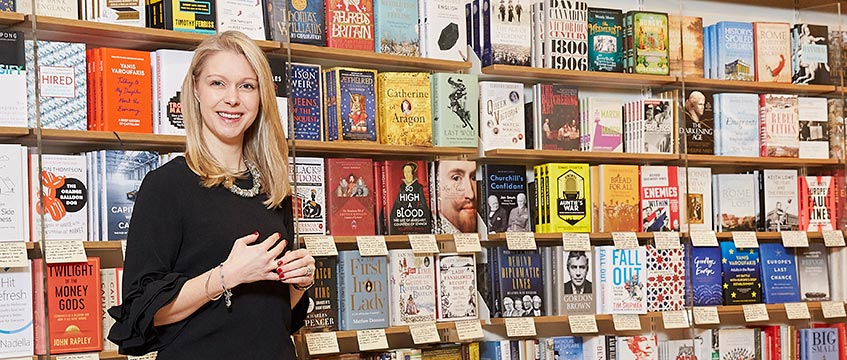When Fire and Fury author Michael Wolff came to London last month to promote his jaw-dropping exposé of Donald Trump’s White House administration, Waterstones was the only organisation to secure him for an event.
The chance to see Wolff in conversation with acclaimed satirist Armando Iannucci for £15 – or £30 including the book – was, of course, a sell-out.
The coup speaks volumes about a business that has gone from flop to bestseller in the seven years since James Daunt was brought in to turn it around. Core to this has been a focus on doing things that cannot be replicated on the internet: from creating friendly, community-focused bookshops to hosting thousands of events each year.
Among those to grab a selfie with Wolff was Waterstones’ head of property, Katie Rees, a woman charged not with the mass store closures some predicted back in 2011 but with finding dozens of new sites for the retailer’s expansion.
“We hope to open 10 to 15 new stores each year over the next three years,” she says. “It’s an exciting challenge.” Waterstones has already opened 20 new shops since 2015, giving it a total of around 280 stores, and moved back into profit in 2016. In the year to 29 April 2017, Waterstones’ pre-tax profits increased from £9.9m to £18m.
Right now, Rees is implementing its expansion strategy against a page-turner of a corporate back story: last October, Alexander Mamut, the Russian oligarch who bought Waterstones for £53m in 2011, appointed investment bankers to explore a £250m sale of the business. Sky News revealed in January that hedge fund Elliott Advisors had been granted a short period of exclusivity to negotiate a deal.
Daunt has said publicly that he hopes any new owner would keep him on, and Rees insists it is “business as usual”.
“I can’t imagine anyone buying us wouldn’t want us to grow. That’s my job,” she says.
New openings
Indeed, Waterstones opened five new bookshops in the run-up to Christmas – in St Neots, Cambridgeshire, Deal in Kent, the Surrey towns of Weybridge and Epsom and London’s Blackheath, SE3. This year’s first opening will see further expansion in Surrey, this time in Reigate, where it has taken a 10-year lease on a 2,000 sq ft store at EPF’s Knight’s Yard renovation project. It will open in the restored listed building this spring, alongside homeware retailer Oliver Bonas.
Also on the cards is Clifton in Bristol, where Rees has just signed the lease on a former HSBC bank in a Regency building. “Most retailers want massive boxes with floor-to-ceiling windows, but we will take historical and quirky buildings,” she says. “The more kinks and walls there are, the more opportunities there are for bookshelves.”
The portfolio is incredibly diverse, encompassing quaint tourist spots, market towns, regional and capital cities and close to 70 shopping centres. Stores range from 900 sq ft up to the 50,000 sq ft Piccadilly, W1, flagship – Europe’s largest bookshop – and everything in between.
So what is Rees looking for in a location?
“I’m looking for a book-buying demographic,” she says, “and nothing beats looking with your own eyes at the pedestrian flow and what people do at different times of the day.”
She spends at least one day a week away from head office above the Piccadilly store, cramming in visits to potential locations.
Perfect blend
Clifton, with its perfect blend of families, young professionals and students, was an easy win. “There are a lot of towns on my list like that, it’s just finding the right thing,” says Rees. Indeed, Daunt himself has said he would open even more stores if only the right units were available. Because while many UK towns and cities are suffering an epidemic of closed shops, Rees has found herself operating in a “deeply competitive” market for stores in affluent locations in which it is easy to become “paranoid about sites being snatched away”.
With this in mind, Waterstones’ approval process is swift: Rees e-mailed Daunt about the Clifton opportunity on a Friday lunchtime and had his approval by 2.30pm. Beaconsfield, Buckinghamshire, will take some further work: it has the perfect demographic – plenty of buggies and plenty of commuters – but trying to secure the right store is like “torture”, Rees says.
She suggests the tide could be turning, however, with the so-called casual dining crunch hitting some of the chains previously targeting the same kind of locations as Waterstones. “I don’t know if the competition now would be as it was last year, when A3 operators were throwing around huge premiums,” she says. “I didn’t expect the bubble to pop so quickly.”
Importantly, Waterstones will not go into towns where there are independent bookstores – a decision made and stuck to by Daunt when Mamut hired him.
“James Daunt has saved bookselling,” Rees enthuses. “His view was that if Waterstones went under, the whole bookselling industry would go under. If we disappeared, all the trade would go somewhere else (such as Amazon) – so all independent booksellers should be left in place.”

According to the Booksellers Association, the independent bookshop sector grew in 2017 for the first time since 1995 – albeit by just one to 868 stores. Daunt himself continues to own his independent chain, Daunt Books, which now comprises nine London bookshops.
Not all bookshops are created equal, however. In Deal, for example, there was an existing bookshop which, on closer inspection, turned out to be selling predominantly gifts, toys, artists’ materials and local books about the Kent town, so Waterstones went ahead there. Henley, on the other hand, with its thriving independent operator, The Bell Bookshop, is firmly off limits.
Making that judgment has become “intuitive” for Rees, who joined Waterstones from Wagamama in June 2016. “I look at everything through Daunt’s eyes,” she says.
Fitting in is clearly important, but the hero of the piece found himself under attack last year after opening three unbranded Waterstones shops in his effort to do just that. In tasteful black painted lettering on pale Farrow & Ball-type colours, the shops are named: The Rye Bookshop, Southwold Books and Harpenden Books. They couldn’t look more distinct from the old Waterstones branding of a giant ‘W’ on a black background or the more modern signage now seen on stores in shopping centres such as the Metrocentre in Gateshead. Some local independent retailers saw the move as a flagrant bid by Waterstones to attract shoppers by posing as an independent itself.
But Rees argues: “It wasn’t supposed to be subterfuge. Waterstones was a homogenous chain when it was owned by HMV. Daunt has devolved power to the booksellers. He wants each store to be bespoke to the market in which it operates.”
Where Waterstones is slotting into high streets with predominantly independent retailers, that means behaving as they do. Uncowed, Daunt is continuing with this strategy.
Empowering booksellers
So much of his focus has been on making Waterstones shops nice places to be, empowering booksellers to select their own stock, improving service, creating an experience that cannot be replicated online. Some 67 stores now have their own Café W, for example, where customers can browse the stock over a flat white.
“With book readings, cafés and the staff’s ability to discuss books, the customer gets more out of it, and it is an enjoyable trip,” says Mark Williams, director at asset manager Hark Group. “I see them as a growing tenant as we move to more mixed-use schemes.”
The less-sexy side has been a drive to bring costs down, with the recent hike in profitability coming off flat sales of £404m. The business is now run with fewer people – both in store and at head office. It has also managed to reduce its rents on some stores when leases have been renewed.
“The whole point of my being here is to save money and help us grow,” says Rees. “With Brexit, things are going to be tricky in the next couple of years. I want to make sure all rents are being decreased as much as we can.”
Shopping centre service charges are a big concern. “We need to be in shopping centres, but we have to be cautious about occupational costs we don’t have control over,” she argues. “On the high street, with an FRI lease, we are running our own destiny.”
However, in recent negotiations, she admits it has been the rent that has been the contentious element.
“We need the rent to be at a certain level to make the store profitable and to future-proof it. It’s not about squeezing landlords for every last penny,” she says.
Flexibility is vital. Rees regularly signs 10-year leases with a break at year five or six and she finds landlords are more willing to talk about the capped and collared rent reviews she wants to avoid an unpalatable rental increase five years down the line. Turnover leases are not embraced at Waterstones but are “not a deal breaker” either. However, Rees won’t use zone A rents, arguing that they simply don’t make sense with how a bookstore presents its stock.
Meanwhile, she is eyeing other potentially lucrative income streams. “We are trying to fight our way into the travel arena,” she says. Tender cycles mean opportunities are few and far between, but the £1bn Manchester airport transformation programme could pave the way.
“We could provide an exceptional experience for customers waiting for their flights – even storytelling for children,” she enthuses.
Waterstones’ new owner will be taking over a business that is ready for further expansion and landlords will be reading the next chapter carefully.
Expansion plans
Waterstones still sees scope for further London expansion:
- Rees is in regular conversation with Battersea Power Station and is weighing up whether the demographic and footfall would be right for Waterstones.
- Waterstones recently lost a store in the City to redevelopment and wants to replace it.
- Victoria Street, SW1, is on the wish list but looks too pricey – so Rees has been researching nearby Pimlico, where she has made repeat visits to weigh up the potential of an area with “lovely shops and houses” but a relatively transient population.
Other towns on the radar are:
- Wetherby, West Yorkshire
- Skipton, North Yorkshire
- Bexleyheath, Greater London
- Beaconsfield, Buckinghamshire
Main image © Tom Campbell
To send feedback, e-mail julia.cahill@egi.co.uk or tweet @egjuliac or @estatesgazette











